
Can a concert, play or painting save a historic building from the wrecking ball? In New Jersey, yes. Centuries-old buildings have been converted into performance spaces, preserving the past while revitalizing the arts scene in local communities.
It’s not unusal for an historic building to maintain its original function after a renovation, says Glenn Ceponis, principal historic-preservation specialist at the New Jersey Historic Trust. Historic homes, for example, are typically transformed into updated homes. Reenvisioning a building as a performance space, he says, is less common, but is especially appropriate in communities lacking a theater or concert hall.
Being able to experience historic buildings helps people understand how we developed as a nation, says Dorothy Guzzo, executive director of the Historic Trust. “Having that past all around you helps you face the future.”
These are four examples of buildings reborn as performance spaces.
Basking Ridge
Farmstead Arts Center
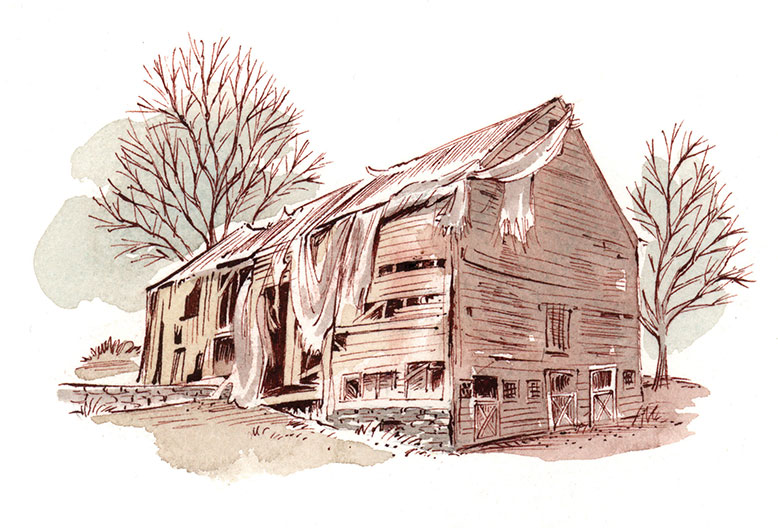
The English-style barn before restoration. Illustration by Gary Hovland
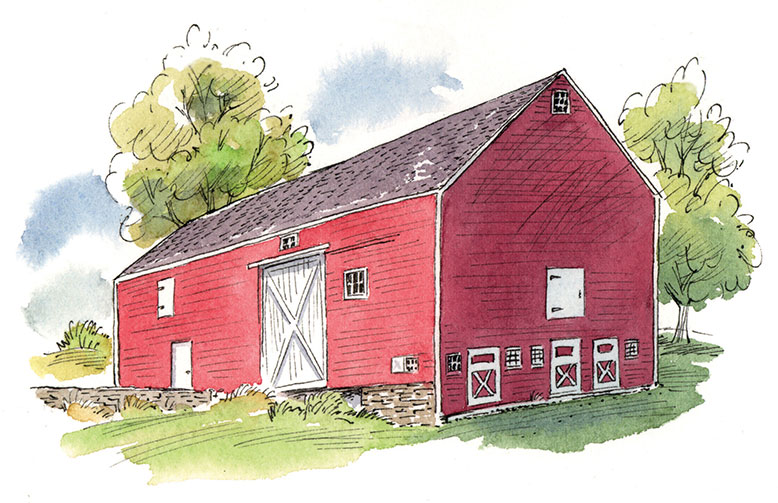
The barn at Farmstead Arts Center today. Illustration by Gary Hovland
History permeates the Kennedy-Martin-Stelle Farmstead in Bernards Township. An early owner, the Reverend Samuel Kennedy, ran a school for boys on the property. Continental Army veteran Ephraim Martin later acquired the land. After the Revolutionary War, Martin was elected to the state Legislature and was instrumental in making New Jersey the first state to ratify the Bill of Rights. From 1794 to 1930, the Stelle family farmed the land. Decades later, the Geier family raised Christmas trees on the farm.
When Bernards Township bought the property in 1999, the farmhouse, barn, cow shed and other buildings were in disrepair. “You would put your hand on the plaster walls and leave your imprint,” says Ann Rosenblum, president of the board at what is now Farmstead Arts Center (450 King George Road, Basking Ridge).
The township planned to raze the property, but the local historical society lobbied against it. Residents, meanwhile, wanted a performing-arts space. “There’s been two projects going parallel this whole time, preserving the site and building an arts organization,” says Carolyn Kelly, vice president of development for Farmstead. “We felt that they go hand in hand because it allows us to create a living history.” The arts center opened on the farm in 2010.
The 1700s English-style barn—unusual for its Dutch framing—is on the state and national Registers of Historic Places. The renovated barn is used for concerts, theater camps, barn dances and productions by the Lord Stirling Theater Company. The 1750s farmhouse holds smaller concerts and art exhibits. Artists rent studio space upstairs, which provides steady revenue.
Restoring the site was a community effort. “It did take a town to roll up their sleeves,” says Kelly. “I myself have waxed these floors.” The barn’s foundation was repaired and the site was made ADA accessible.
The township used its open-space trust fund to buy the 36-acre property (the farm sits on four acres) for $3.4 million and helped fund the restoration. Farmstead also got funding from the New Jersey Historic Trust, the Somerset County Historic Preservation Grant Fund and the 1772 Foundation. The restoration has cost $1.8 million so far, according to Rosenblum. Farmstead is using a grant this spring to convert another building into a history and welcome center. Another goal is to add staff and extend operating hours. For now, operations manager Kathy Harris is the only paid employee.
“Artists are extremely happy to have this place,” says Rosenblum. The center gets more requests to display art than it can handle.
Bernards Mayor Carolyn Gaziano says many concerts and lectures sell out. “The people who have come here once all come back.”
Farmstead has won the New Jersey Preservation Award and Somerset County’s Historic Preservation Award. Rosenblum says the Historic Trust called it “a model for adaptive reuse,” and historic groups have requested tours, looking for ideas.
“People enjoy stepping back down our driveway and leaving the 21st century,” says Kelly. “They like the fact that we’re a little rough around the edges. It’s a reason to put their boots on.”
Flemington
Stangl Factory
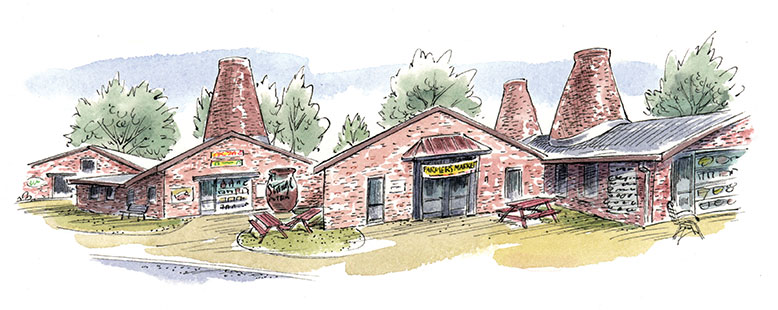
Stangl Factory hosts live music, art galleries, a wellness studio and more. Illustration by Gary Hovland
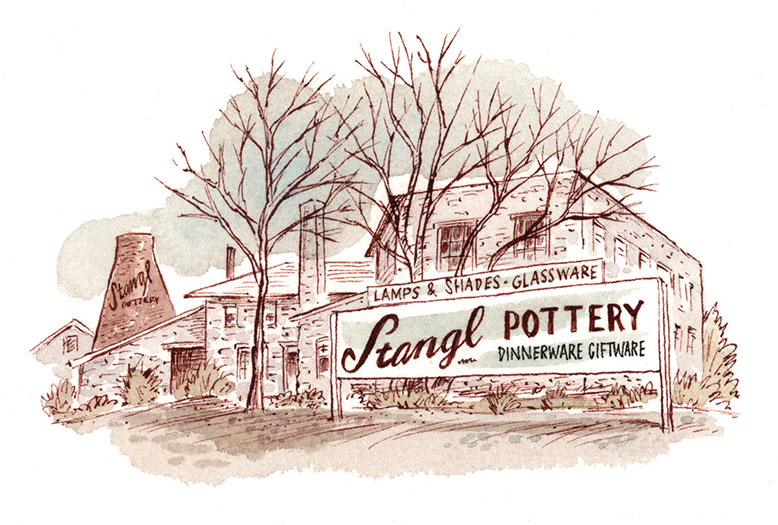
The factory before restoration. Illustration by Gary Hovland
“Most people would’ve definitely bulldozed the property, which would’ve been a shame,” says George Eckelmann. “It has its own sort of charm.” Eckelmann and his partner, Frank Banisch, bought the abandoned Stangl Pottery site in 2011 for $800,000, renamed it Stangl Factory and turned it into a buzzing arts and events center (Mine Street and Stangl Road, Flemington).
The site had been home to a series of pottery companies since 1814, when Samuel Hill began producing drainpipes and storage crocks from the local clay. It eventually switched from a production facility to become one of America’s first retail-only factory outlets. Tourists came to buy hand-painted dinnerware from the 1930s until Stangl closed in 1978.
“The original portion of the building, nobody had used in over 50 years,” says Eckelmann. “There were no windows, the walls were rotten, poison ivy was growing right through the walls, it had dirt floors.” According to Banisch, the partners have spent nearly $1 million on renovations so far.
The site is in the Flemington Historic District, so the factory exterior had to be kept historically accurate. The 35-foot-tall brick kilns, the last three in the state, have been put to good use. Customers can drink coffee inside one at the Factory Fuel Co., view art inside another at the Kev Von Holt Gallery, or have a psychic reading inside the third. Other tenants include Kissimmee River Pottery, the Blue Fish Grill restaurant, and a wellness and physical-therapy studio.
The Stangl Stage area, an open space bedecked with Stangl Pottery signs, is designed for flexibility. When it isn’t hosting a show or private event, it houses a farmers’ market.
Banisch and Eckelmann’s goal from the start was a community arts and culture center. Eckelmann and other volunteers of Flemington Rocks produce up to 10 Stangl Stage concerts a year. Outside groups also rent the space for shows and other events.
Live music is part of the mission. “These events [are] a big deal to the community,” Eckelmann says. Recent performers have included local act Marshall’s Dixieland Jazz Band and singer/songwriter David Wilcox.
Despite logistical issues—they don’t have dressing rooms or a permanent stage—the owners want to increase the number of shows. “We definitely can sell out tribute bands easily,” says Eckelmann, “but we also want to keep original performers going.”
Future plans for the site include an independent movie theater. “Whether it works economically, who the hell knows? But I’m willing to try it,” says Eckelmann.
In 2014, the New Jersey Business and Industry Association gave Stangl its New Good Neighbor Award, presented to projects that create jobs and contribute to the state’s economic growth.
Eckelmann says just like the factory, the road it stands on was empty when he and Banisch signed on. “As soon as our restaurant opened, we were jamming all the time. We estimate that we get about 10,000 visits a month. It provided a spark at that end of the town, and now all the stores on the street are full.”
Ewing
1867 Sanctuary at Ewing
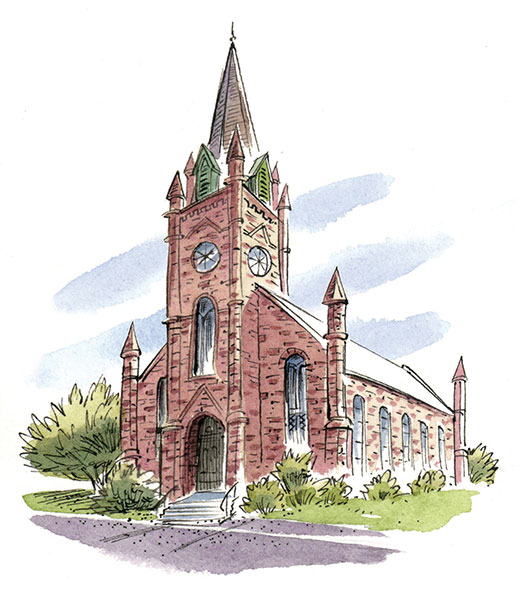
1867 Sanctuary hosts concerts, open-mic nights and stage shows. Illustration by Gary Hovland
“It looks like a church, but it’s not church,” jokes Bob Kull. “People will come in, and they’ll sit in the back like it’s church.” 1867 Sanctuary hosts jazz, classical and folk concerts, open mic nights and stage shows. Kull handles event scheduling for 1867 Sanctuary. His wife, Helen, is on the board of Preservation New Jersey, which holds the lease on the building. The stately stone structure, built in 1867, is one of New Jersey’s few Romanesque Revival churches. It was the fourth building used by the First Presbyterian Church of Ewing on the site, beginning in 1712. The surrounding cemetery includes the graves of 39 Revolutionary War veterans.
The Presbyterian congregation (of which the Kulls are members) left the building in 2007 because they couldn’t afford to maintain it. But, the community didn’t want the building demolished. “Many people had been married there, or their loved ones had memorial services there,” says Helen.
Preservation New Jersey signed a 50-year lease with the Presbytery of New Brunswick for the building in May 2012 and began renovations, including replacing the boiler, patching the walls, creating a stage area and installing wood flooring. A combination of grants and private donations funded the work. The Sanctuary (101 Scotch Road) began to hold performances in February 2016.
“Everybody hears everything perfectly, even the most quiet performers,” says Bob. “A lot of performers are used to playing weddings or at clubs or bars or restaurants. They keep calling us because it’s a treat to be there, where people are actually paying attention.” Recent performers included jazz/pop vocalist Michelle Wiley and classical guitarist Allen Krantz, both Philadelphia-based artists.
Preservation New Jersey will celebrate the 150th anniversary of the building this fall. In the meantime, they are trying to spread the word about the venue. “People are telling us that we’re doing the right things,” Bob says. The Kulls estimate it costs between $3,000 and $5,000 a month to run the venue; $250,000 has been spent on sanctuary renovations since 2012.
“It’s still a very spiritual place,” says Helen.
Cape May
Cape May Stage
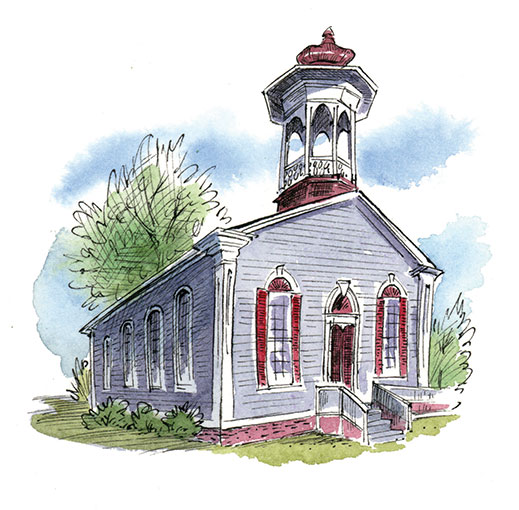
Cape May Stage is housed in a former church. Illustration by Gary Hovland
To Roy Steinberg, artistic director at Cape May Stage (405 Lafayette Street), there’s nothing unusual about using a former church building as a theater. “The way the theater started—Western theater, anyway, going back to the ancient Greeks—it was a religious festival. And in medieval times, literally in the church, they would have these medieval mystery plays, and the guilds would act out the stories in the Bible on the steps of the church. So it makes sense to me that we’re in what was once a church.”
The building, which dates to 1853, served the Cape Island Presbyterian Church as well as Methodist and Episcopalian congregations. It was nearly demolished in the 1950s, but a local preservationist convinced the city to use it as a community center. In 1993, Cape May Stage, an Equity theater company, began to use the center for productions. The company kicked off a $1.4 million capital campaign in 2004 to install a state-of-the-art theater.
Cape May Stage has continued to make improvements to the building, which is listed on the National Register of Historic Places. “We had so many people wanting to see our plays that we were turning away as many as 40 people a night,” says Steinberg. To add seats, they converted the choir loft into a mezzanine. They’ve also added an outdoor ticket booth for the busy season in July and August.
The work has been funded through grants from the Geraldine R. Dodge Foundation, the Shubert Foundation and the New Jersey State Council on the Arts, as well as individual foundations. The company also holds an annual giving campaign and gala. Since the initial renovation, Steinberg estimates they’ve spent another $500,000 on maintenance. “We’re very responsible stewards of the building,” he says.
Under Steinberg’s direction, Cape May Stage has gained a reputation for productions of thought-provoking plays such as Ayad Akhtar’s Disgraced and Other Desert Cities by Jon Robin Baitz. “We’ve had a wonderful embrace of the audience for challenging plays,” he says.
Steinberg, a former Broadway actor and television producer, doesn’t have trouble attracting talent. Actors who have graced the stage include Tony-winner Karen Ziemba (Contact, Steel Pier), Laura Woyasz (Wicked) and Lynn Cohen (Sex and the City, The Hunger Games). But location helps.
“Cape May is such a gloriously beautiful place. It’s not hard to convince people to have a little holiday and come perform in a play they’ve always wanted to do.”
Marlaina Cockcroft is a Morris County-based freelance writer.
